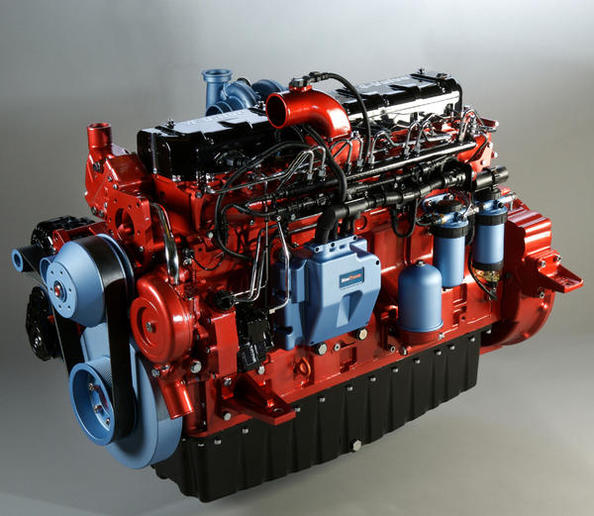You should upgrade or use an alternative browser.
- Thread starter JD Seller
- Start date
Eldon (WA)
Well-known Member
Deere currently uses a 5 cyl 3 liter diesel in some 5000 series tractors.
Ken Christopherson
Well-known Member
Bruce from Can.
Well-known Member
- Location
- Woodville, Ontario, Canada
Throop
Member
- Location
- Aurelius, NY
Rich
How about 28 cylinder Pratt and Whitney
Brendon-KS
Well-known Member
- Location
- Goessel, KS
Traditional Farmer
Well-known Member
- Location
- Virginia
BarnyardEngineering
Well-known Member
- Location
- Rochester, NY
Successful radial airplane engines had odd numbers of cylinders to avoid having two cylinders firing right next to each other, so the engine would run smoothly. 1-3-5-7-2-4-6 would be the firing order on a 7 cylinder. Note how it would fire every other cylinder, and end up back at 1.
I wonder if the Sisu engine has the same firing order. Seems counterproductive to take a dynamically balanced inline 6 and screw it up like that though...
fixerupper
Well-known Member
coonie minnie
Well-known Member
Machnegative
Member
gtractorfan
Well-known Member
INTERESTING!
A 4 cycle engine fires all it's cylinders over two turns, 720? of crankshaft rotation, 720? divided by 5 cylinders = a power stroke starting every 144?.
Doesn't quite seem to work out to "a power stroke every 60 degrees!
Seven cylinder would be 720? divided by 7 cylinders = a power stroke starting every 102.9?.
Texasmark1
Well-known Member
buickanddeere
Well-known Member
The inline six is one of the better compromises of size, being compact , low cost , simplicity, strength, inherent balance and power.
Texasmark1
Well-known Member
MUCH smoother than a 4, quieter too.
I've put 150,000 miles on an in-line 5 Volvo engine. The 2.5L in-line 5 makes 218 hp, roughly same hp as
the 5.0L HO Mustang engine on half the displacement, torque was down a little from the 5.0L. But with
variable valve timing on intake & exh. it had a flat torque curve from 1750 rpm to over 4000 rpm.
I know GM built an in-line 5, That was pre-Bailout when they couldn't afford 6 pistons per engine.
kcm.MN
Well-known Member
- Location
- NW Minnesota
farmer boy
Well-known Member
farmer boy
Well-known Member
Brendon-KS
Well-known Member
- Location
- Goessel, KS
flying belgian
Well-known Member
buickanddeere
Well-known Member
Don’t get overly offended . It was more of a joke about 5 cylinder engines .(quoted from post at 11:17:15 02/19/18) B&D - I disagree! A 5 cylinder is almost as smooth as a 6,and as powerful given equal displacement,and
MUCH smoother than a 4, quieter too.
I've put 150,000 miles on an in-line 5 Volvo engine. The 2.5L in-line 5 makes 218 hp, roughly same hp as
the 5.0L HO Mustang engine on half the displacement, torque was down a little from the 5.0L. But with
variable valve timing on intake & exh. it had a flat torque curve from 1750 rpm to over 4000 rpm.
I know GM built an in-line 5, That was pre-Bailout when they couldn't afford 6 pistons per engine.
buickanddeere
Well-known Member
(quoted from post at 18:10:42 02/19/18) FWIW- Sisu is a Finnish word...loosely translated, means "guts". I married one.
You married "guts". ?
MarkB_MI
Well-known Member
- Location
- Motown USA
MUCH smoother than a 4, quieter too.
An inline six is inherently balanced, as the crank throws are 120 degrees apart. A three cylinder inline is also balanced for the same reason.
GM developed the inline five to solve a specific problem: The Isuzu-designed GMT355 truck didn't have room under the hood for either an inline six or a V-6. And a bigger engine than the four-banger was needed for the US market. A friend of mine worked on the project, and he said they had a lot of vibration problems. I think they had to add a second balance shaft to get the vibration under control.
I have turbo 5 cylinder in our 1992 kraut wagon. It is better than the first 4 banger we had, you didn't dare try to pass with the ac on. But I will take my 2010 Sienna any day.
I used to work on a boat that had a two stroke
Sulzer 7 RND 76. It's been a while but I think it was around 17,000 hp.
like this one
Texasmark1
Well-known Member
Similar threads
- Replies
- 14
- Views
- 722
We sell tractor parts! We have the parts you need to repair your tractor - the right parts. Our low prices and years of research make us your best choice when you need parts. Shop Online Today.
Copyright © 1997-2024 Yesterday's Tractor Co.
All Rights Reserved. Reproduction of any part of this website, including design and content, without written permission is strictly prohibited. Trade Marks and Trade Names contained and used in this Website are those of others, and are used in this Website in a descriptive sense to refer to the products of others. Use of this Web site constitutes acceptance of our User Agreement and Privacy Policy TRADEMARK DISCLAIMER: Tradenames and Trademarks referred to within Yesterday's Tractor Co. products and within the Yesterday's Tractor Co. websites are the property of their respective trademark holders. None of these trademark holders are affiliated with Yesterday's Tractor Co., our products, or our website nor are we sponsored by them. John Deere and its logos are the registered trademarks of the John Deere Corporation. Agco, Agco Allis, White, Massey Ferguson and their logos are the registered trademarks of AGCO Corporation. Case, Case-IH, Farmall, International Harvester, New Holland and their logos are registered trademarks of CNH Global N.V.
Yesterday's Tractors - Antique Tractor Headquarters
Website Accessibility Policy


